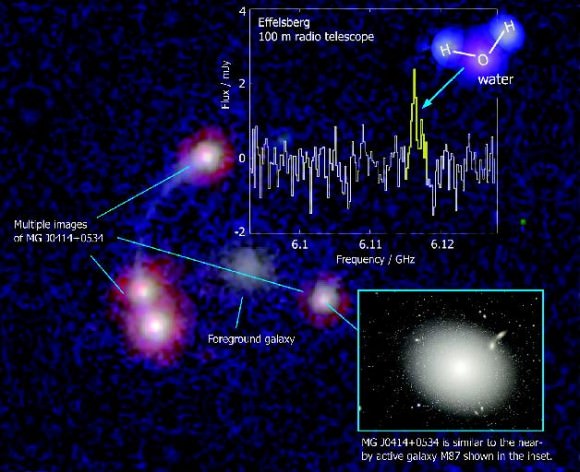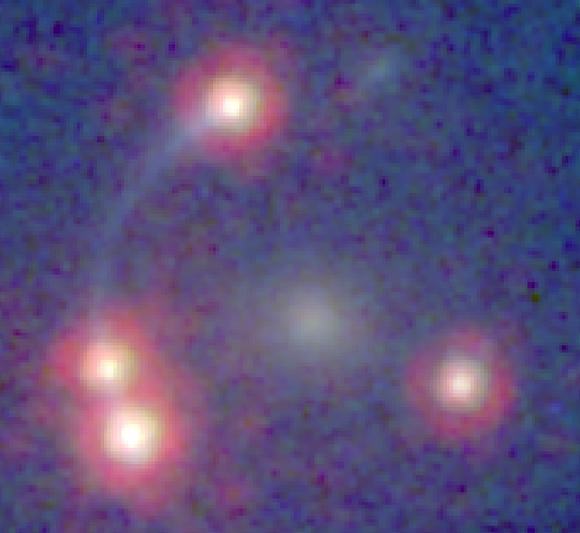[/caption]
Astronomers have found the most distant signs of water in the Universe to date. The water vapor is thought to be contained in a maser, a jet ejected from a supermassive black hole at the center of a galaxy, named MG J0414+0534. The radiation from the water maser was emitted when the Universe was only about 2.5 billion years old, a fifth of its current age. “The radiation that we detected has taken 11.1 billion years to reach the Earth, said Dr. John McKean of the Netherlands Institute for Radio Astronomy (ASTRON). “However, because the Universe has expanded like an inflating balloon in that time, stretching out the distances between points, the galaxy in which the water was detected is about 19.8 billion light years away.”
The water emission is seen as a maser, where molecules in the gas amplify and emit beams of microwave radiation in much the same way as a laser emits beams of light. The faint signal is only detectable by using a technique called gravitational lensing, where the gravity of a massive galaxy in the foreground acts as a cosmic telescope, bending and magnifying light from the distant galaxy to make a clover-leaf pattern of four images of MG J0414+0534. The water maser was only detectable in the brightest two of these images.
“We have been observing the water maser every month since the detection and seen a steady signal with no apparent change in the velocity of the water vapor in the data we’ve obtained so far, McKean said. “This backs up our prediction that the water is found in the jet from the supermassive black hole, rather than the rotating disc of gas that surrounds it.”

Although since the initial discovery the team has looked at five more systems that have not had water masers, they believe that it is likely that there are many more similar systems in the early Universe. Surveys of nearby galaxies have found that only about 5% have powerful water masers associated with active galactic nuclei. In addition, studies show that very powerful water masers are extremely rare compared to their less luminous counterparts. The water maser in MG J0414+0534 is about 10,000 times the luminosity of the Sun, which means that if water masers were equally rare in the early Universe, the chances of making this discovery would be improbably slight.
“We found a signal from a really powerful water maser in the first system that we looked at using the gravitational lensing technique. From what we know about the abundance of water masers locally, we could calculate the probability of finding a water maser as powerful as the one in MG J0414+0534 to be one in a million from a single observation. This means that the abundance of powerful water masers must be much higher in the distant Universe than found locally because I’m sure we are just not that lucky!” said Dr McKean.
The discovery of the water maser was made by a team led by Dr. Violette Impellizzeri using the 100-metre Effelsberg radio telescope in Germany during July to September 2007. The discovery was confirmed by observations with the Expanded Very Large Array in the USA in September and October 2007. The team included Alan Roy, Christian Henkel and Andreas Brunthaler, from the Max Planck Institute for Radio Astronomy, Paola Castangia from Cagliari Observatory and Olaf Wucknitz from the Argelander Institute for Astronomy at Bonn University. The findings were published in Nature in December 2008.
The team is now analyzing high-resolution data to find out how close the water maser lies to the supermassive black hole, which will give them new insights into the structure at the center of active galaxies in the early Universe.
“This detection of water in the early Universe may mean that there is a higher abundance of dust and gas around the super-massive black hole at these epochs, or it may be because the black holes are more active, leading to the emission of more powerful jets that can stimulate the emission of water masers. We certainly know that the water vapour must be very hot and dense for us to observe a maser, so right now we are trying to establish what mechanism caused the gas to be so dense,” said Dr McKean.
McKean presented the team’s findings at the European Week of Astronomy and Space Science in the UK this week.
Source: RAS


I wonder if for such measurements the Doppler effect has to be/been taken into account?
Since it took so long for the radiation to get here, the object it came from must be travelling in the opposite direction as we (earth) do, maximizing relative velocity, maximizing Doppler effect.
However, I don’t know if the second image is scientifically correct, but 6GHz for a water maser seems rather low, even with Doppler included. A quick Google search learns that water masers emit around 22GHz?
How do they determine the distance of such an object anyway? Is this done by measuring the Doppler shift on a water maser emission? But isn’t the characterisation of the maser done by measuring the spectral lines? Smells like a chicken-egg problem.
Silenus, yes, the Doppler Effect is taken into account for all of those universe-distant obsevations. Redshift shifts those absorption signals just like it shifts all other light signals due to expansion.
While digging through the NED database for info on this object (it seems to be well studied, with over 120 papers listed) where I came across “A search for water masers in the gravitationally lensed quasars H 1413+117 and MG 0414+0534” by Wiltner et al in the March 1999 issue of Astronomical Journal (paper here: http://www.iop.org/EJ/article/1538-3881/117/3/1139/980480.web.pdf?request-id=6c51b451-445b-4286-bef0-7ac6d318e8c9 ). While no detection in either object was made, the researchers were looking for the same 22 GHz water maser line as the new study. They were using the Australian Telescope Compact Array( ATCA ) with obviously a limited detection capability compared to the more sensitive observations used here. So this new search was not the first, but made the first successful observation of this maser activity. If at first you don’t succeed……
@Silneus, Astronomers take the doppler shift of lines into account all the time. This is why astronomers who want to study the Lyman-alpha line of hydrogen (normally in the deep ultraviolet at rest) look at the near to mid-infrared portion of the spectrum for the line emitted by extremely distant objects. The line they’re looking for in the spectrum has ‘red-shifted’ from the ultraviolet to the infrared portion of the electromagnetic spectrum. Same deal here. This is a very distant object, the discrepancy you note reflects that enormous redshift.
So applying Dopplers formula, gives me that the observed object (the maser) is moving away from earth at app. 0.73c (or 73% of light speed) (assuming that the observed frequency is around 6GHz as indicated in the second picture).
Impressive.
But this speed also results in a mass increase of app. 45% according to relativity theory. Don’t know how to interprete this though.
Anyway, amusing brain exercise
@ Silenus, After a closer reading of the 1999 paper I linked to above, on pg. 3 under Conclusions the researchers state explicitly that they searched for the 22 GHz maser line that was redshifted to 6 GHz. In addition, they deliberately searched a radio swath centered on 6 GHz, since the maser emission line is quite sharp. The new observations must also rule out the possibility of some weird possibility of maser emission from the lensing galaxy itself (probably easy, given the redshift difference alone). Interestingly, the paper also notes their nondetection of water masers as probably related to the paucity of such galaxies in the nearby universe, just as mentioned in the article above. If they only knew then that they were looking at a quasar with a water maser!
Silenus: I could be wrong, but I don’t think special relativity applies to objects speeding away from us due to the expansion of the Universe because it’s literally space itself that’s moving away from us, not the object, per se.
Okay, I’ve asked this before to no response…..
How does a Universe that is 13.73 billion years old (unstretched?!?!) create a distance that is 19.8 billion years??
Doesn’t that mean that virtually everything we measure in the Universe has a “stretched” distance??
Distances can distort because the dynamics of space is stretching out space or moving points apart. Particles in spac or spacetime can’t move faster than light in a local frame, but different local frames can be comoved by the dynamics of spacetime.
Lawrence B. Crowell